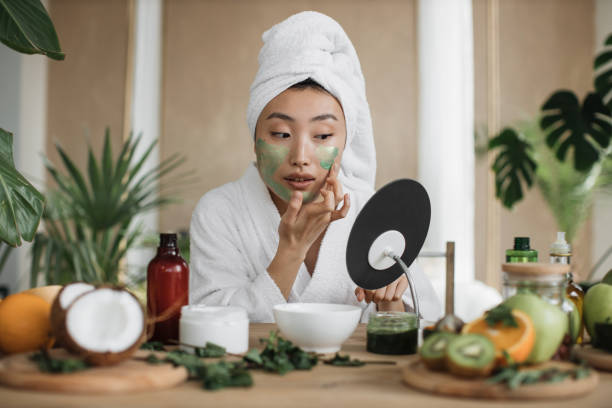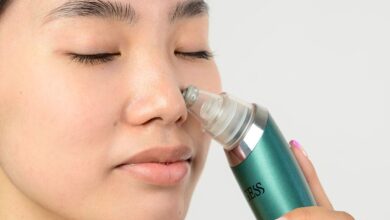When to use a face mask in skincare routine

Face masks have become an important part of many people’s skincare practices, offering a change of benefits conditional on the type of mask used. However, knowing when to use a face mask in your skincare predictable is vital to doing the best results. In this blog post, we will discover the best times to include a face mask into your skincare routine to ensure maximum efficiency.
Understanding Your Skin’s Needs
Classifying what your skin truly needs is the initial step in efficiently mixing a face mask into your skincare rule. Each person’s skin is sole, and therefore, the benefits one may seek from a face mask can much contrast. Whether you’re opposing dry covers, looking to calm acne-prone skin, seeking to improve a dull skin, or aiming to tackle the signs of aging, there’s a face mask planned to meet those needs.
For instance, those with dry skin might sink towards deeply hydrating masks infused with fixings like hyaluronic acid, while persons with oily or acne-prone skin may benefit from clay or charcoal masks that help engross excess oil and cleanse pores. Likewise, if your goal is to achieve a happier, more vibrant face, masks covering vitamin C or other improving agents can be mostly beneficial. Equally important is since how your skin’s needs may alteration with the seasons, your lifestyle, or even hormonal variations, requiring you to adapt your choice of mask hence. By taking the time to appreciate and address your skin’s specific worries, you can select a face mask that not only matches your skincare dull but also uplifts it, flagging the way to better, more glowing skin.
The Best Time of Day to Apply a Face Mask
While you might be curious to use a face mask at any time of day, choosing the right moment can expressively enhance its benefits. Evening hours are often careful the prime time for face mask application. This preference is based on the skin’s natural beats; at night, the skin switches into a mode of repair and upgrading, making it more receptive to the nutritious fixings found in your chosen mask. By aligning your face mask ritual with this nightly cycle, you’re not only indulging in a relaxing pre-bedtime routine but also optimizing the mask’s potential to improve your skin’s health and arrival.
Morning application, on the other hand, can be right for certain types of masks, especially those planned to refresh the skin and prep it for the day gaining. However, due to the propel of morning routines and the need for quick, efficient skincare, evening applications remain a favored choice for most. This timing allows for a more easy, thorough treatment without the pressure of immediate makeup application or sun contact, which can affect the efficacy of some mask constituents. So, while your skincare needs and preferences finally dictate the best time to apply a face mask, bring into line this step with your skin’s nightly repair process can intensify results, making evenings an ideal choice for most.
Before or After Cleansing: The Optimal Sequence
Navigating the correct order in your skincare routine is pivotal for pretty the efficacy of a face mask. The agreement among skincare experts places heavily towards applying your face mask post-cleansing. This sequence is critical for a few absorbing reasons. Cleansing your skin first acts as a opening step, effectively far-reaching away any surface dirt, makeup residue, and excess oils that could hinder the mask’s ingredients from sharp deeply into the skin. Imagine your skin as a image; just as an artist requires a clean surface to begin painting, your skin benefits from being clear of foams to fully absorb the nutritious components of a face mask.
Moreover, applying a mask on freshly cleansed skin allows for the active ingredients within the mask to tackle the skin’s worries more directly and efficiently, without the barrier of daily grime and accrual. It’s akin to opening the door for these beneficial fixings to work their magic in an free environment. On the other hand, applying a mask before cleansing could result in tricking dirt and oil beneath the mask, potentially leading to clogged pores or annoyance. Hence, for a face mask to truly deliver its promised benefits, embracing it as a follow-up to cleaning is a step you wouldn’t want to skip in your skincare ritual.
Frequency Matters: How Often to Use a Face Mask
Determining the ideal frequency for joining a face mask into your skincare regime hinges on several factors, with your skin type and the specific mask you’re using. Generally, applying a face mask once to three times a week is wise for most skin types, striking a balance between reaping the benefits and avoiding over-stimulation or frustration.
Those with more hardy or mainly oily skin may find that their skin can handle a mask up to three times a week, whereas individuals with delicate or dry skin types might benefit from a more traditional approach, limiting their use to once a week. It’s vital to pay close attention to how your skin replies after each request. Observing any changes, positive or bad, can guide you to adjust the frequency for best results.
Additionally, the type of mask plays a important role; for instance, gentle hydrating covers can often be used more normally than more intensive actions, such as exfoliating or clearing masks, which might warrant more spaced-out applications to prevent emphasizing the skin. Always order your skin’s immediate reaction and ease level to tailor the regularity of face mask claims, ensuring you provide your skin with the benefits it needs without producing undue stress.
Special Occasions: Prepping Your Skin for Big Events
For those milestone moments in life that demand you look and feel your absolute best, joining a face mask into your skincare routine can be a game-changer. A carefully chosen mask applied one or two days before an event can work marvels, ensuring your skin appears luminous and photo-ready. Opt for a hydrating mask if you’ve been feeling dry, as it can desirable the skin with wetness, reducing the appearance of fine lines and imparting a dewy, young glow.
For those looking to brighten their skin, a mask with vitamin C or other improving ingredients can help to even out skin tone and enhance radiance. It’s crucial, however, to stick with crops you know and trust. The days leading up to a significant event are not the time for research. Using a familiar face mask reduces the risk of unforeseen reactions, letting you step into your big day with confidence. So, as you plan your outfit and fittings for that special occasion, don’t forget to prepare your skin as well, making it the perfect canvas for a unforgettable look.
Signs Your Skin Needs a Break from Face Masks
While joining face masks into your skincare regimen can yield amazing benefits, it’s vital to stay attuned to your skin’s feedback. Indicators such as increased compassion, pronounced redness, unusual dryness, or an unexpected onset of escapes can be your skin’s way of signaling that it’s time to pause the use of face masks.
These replies might suggest that your skin is being overcome, either by the frequency of application or the strength of the ingredients within the masks. It’s vital during these times to scale back and allow your skin the opportunity to restore its balance obviously. Continuing to use face masks without heed to these signs could impair the issues, leading to prolonged distress or skin damage. Therefore, observing your skin’s response after each mask application is vital, as it guides you to adjust your skincare does for optimal skin health. Remember, the goal of a face mask is to enhance your skin’s beauty, not to donate to stress or irritation.
Conclusion
Navigating the proper use of face masks within your skincare routine can meaningfully raise your skin’s health and appearance. The trip begins with a deep understanding of your skin’s unique requirements, followed by careful selection and judgement of your face mask application. Optimal results are achieved by mixing face masks during the sundown when your skin is naturally more receptive to healing and renewal, ensuring that this step is done on a cleansed face to allow for maximum interest of beneficial components. Frequency of use should be couturier to your skin’s acceptance and the specific needs it may have, bearing in mind that control is key to avoiding overstimulation or impatience.




4 Comments